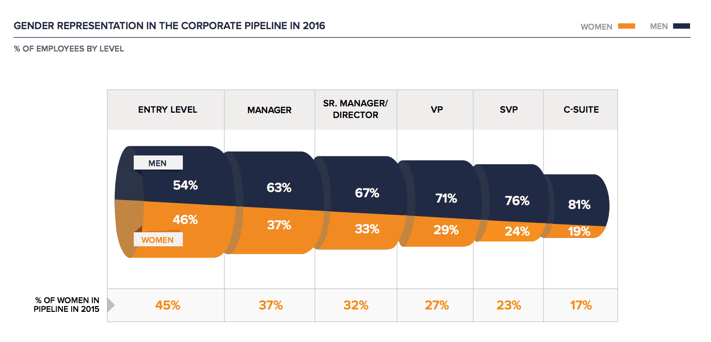
As Women’s History Month draws to a close, it’s a good time to reflect on and celebrate the contributions of women in all industries and sectors. It’s also a good time for employers to take a look at the state of women in the workplace, and start taking action in order to create a diverse workforce.
Female employees now make up a greater percentage of the working population than in past decades. Many notable employers have also made public commitments to advancing women to all levels of leadership. But despite these positive signs, there are still some major hurdles for women to overcome at work.
According to the 2016 Women in the Workplace report by McKinsey and Lean In, women are less likely to get an initial promotion to manager level than men. Unfortunately, the disparities only worsen from there.

This is not only a hindrance to the women being left behind, but to their companies and the economy as a whole. The benefits of having women in leadership positions are numerous and well-documented. Companies with more women in leadership see more innovation, collaboration, and profitability. Organizations who don’t explicitly make equality a priority often miss out on these benefits.
If your company doesn’t already have official policies in place to advance women in the workplace, here are some ways to get started:
Engage company leadership in the discussion
Get buy-in from the leaders of each department, and of the company as a whole. Share how other companies in your industry have seen successful outcomes by making diversity central to their growth strategies. Discuss what systemic challenges have made it difficult for women to advance in your organization. Make plans for how managers can remove those roadblocks.
Observe your corporate culture
How does your culture encourage or discourage women from taking on more challenging roles? What are the unwritten rules of your workplace that may be preventing women from advancing? Do the men in your company need more diversity training? What professional development tools might you have made available to men in your workplace, but not to women?
In any organization, it’s more likely the unspoken operating rules and unintended oversights than actual policies that prevent diverse employees from reaching their full potential.
Identify metrics and set goals
Look at metrics about your company’s record for hiring, advancement, compensation and retention of women. Are you hiring close to 50% women for entry-level positions, only to see those numbers decrease for leadership positions? At what level do women stop advancing in your company? Why is that? What can you do to help provide a more supportive environment for women to advance beyond that level?
Use your existing resources
Identify women who have successfully advanced in your company and ask them what would have helped them achieve their goals more easily. Where did they find the most resistance? How did they push through it? Get their input on how your organization can help newer female employees develop and take on new challenges.
If it would be useful in your company, provide mentorship opportunities for newer female employees. This can help them identify and challenge any unspoken rules or attitudes in the workplace that have prevented women from advancing in the past.
Look for ways to provide flexibility and support
One of the most commonly-cited reasons for the lack of women in leadership positions is motherhood. In the past several decades, broader cultural attitudes around parenting roles may have shifted to be a bit more egalitarian. Still, mothers are often strapped with a bigger family burden for the first several years of a child’s life.
Because of the high cost and logistical challenges of childcare, many women are forced out of the workplace, even if only temporarily. Providing paid parental leave, the ability to work from home when necessary, and/or flexible hours for all employees (including men) is a wise move. These considerations allow employees to care for their families while continuing to contribute to the workforce meaningfully.
If your organization has not made gender equality a priority before now, start a discussion with company leadership. See what steps they’re open to taking immediately to create an environment that encourages full female participation. Increasing the advancement of bright, capable women to leadership positions is not only the right thing to do; it's also good business.
